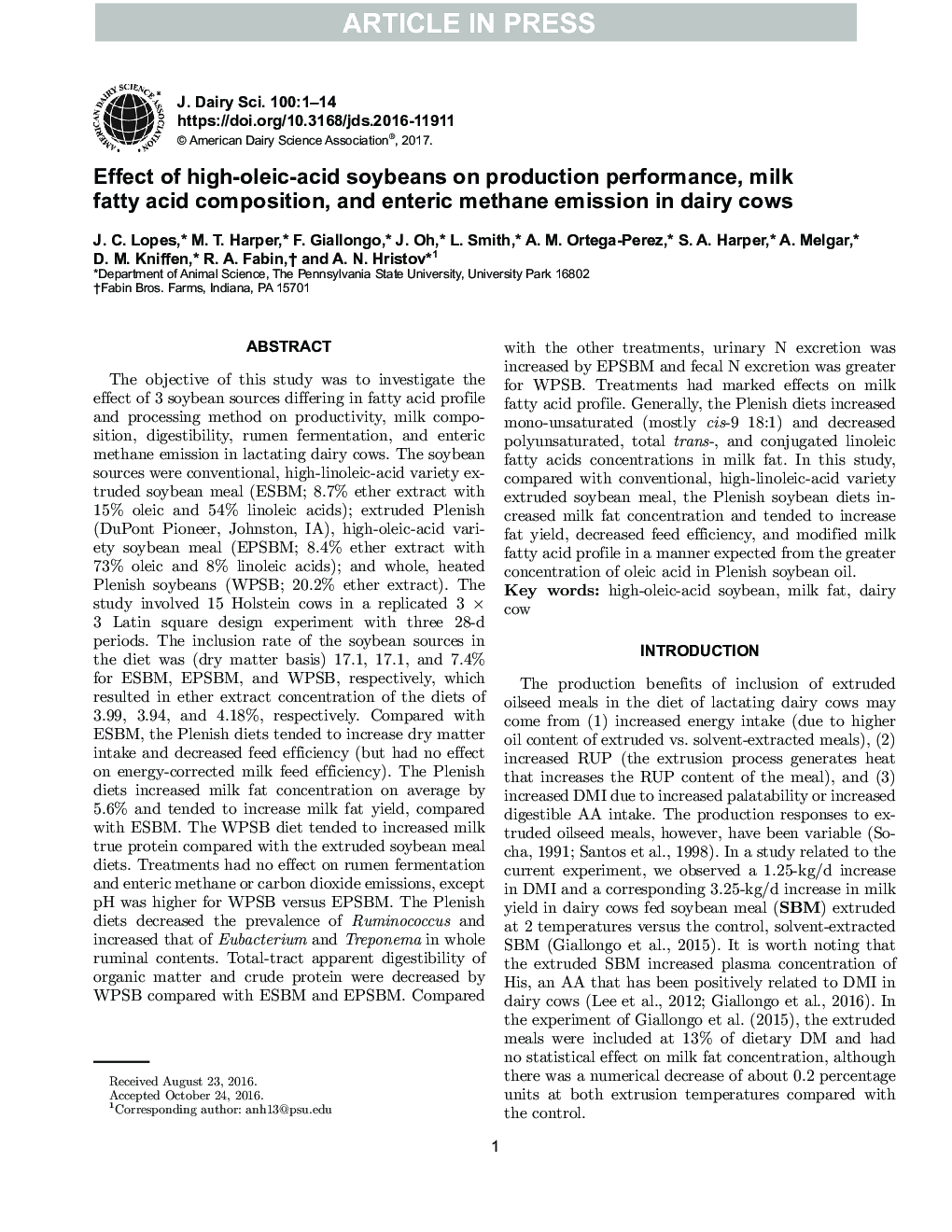| کد مقاله | کد نشریه | سال انتشار | مقاله انگلیسی | نسخه تمام متن |
|---|---|---|---|---|
| 5542421 | 1402518 | 2017 | 14 صفحه PDF | دانلود رایگان |
عنوان انگلیسی مقاله ISI
Effect of high-oleic-acid soybeans on production performance, milk fatty acid composition, and enteric methane emission in dairy cows
ترجمه فارسی عنوان
اثر سویا با اسیدهای لیپید اسیدی بر عملکرد تولید، ترکیب اسید چرب شیر و انتشار متان در داخل گاوهای لبنی
دانلود مقاله + سفارش ترجمه
دانلود مقاله ISI انگلیسی
رایگان برای ایرانیان
کلمات کلیدی
سویا با اسید سولفوریک، چربی شیر گاو شیری،
موضوعات مرتبط
علوم زیستی و بیوفناوری
علوم کشاورزی و بیولوژیک
علوم دامی و جانورشناسی
چکیده انگلیسی
The objective of this study was to investigate the effect of 3 soybean sources differing in fatty acid profile and processing method on productivity, milk composition, digestibility, rumen fermentation, and enteric methane emission in lactating dairy cows. The soybean sources were conventional, high-linoleic-acid variety extruded soybean meal (ESBM; 8.7% ether extract with 15% oleic and 54% linoleic acids); extruded Plenish (DuPont Pioneer, Johnston, IA), high-oleic-acid variety soybean meal (EPSBM; 8.4% ether extract with 73% oleic and 8% linoleic acids); and whole, heated Plenish soybeans (WPSB; 20.2% ether extract). The study involved 15 Holstein cows in a replicated 3 Ã 3 Latin square design experiment with three 28-d periods. The inclusion rate of the soybean sources in the diet was (dry matter basis) 17.1, 17.1, and 7.4% for ESBM, EPSBM, and WPSB, respectively, which resulted in ether extract concentration of the diets of 3.99, 3.94, and 4.18%, respectively. Compared with ESBM, the Plenish diets tended to increase dry matter intake and decreased feed efficiency (but had no effect on energy-corrected milk feed efficiency). The Plenish diets increased milk fat concentration on average by 5.6% and tended to increase milk fat yield, compared with ESBM. The WPSB diet tended to increased milk true protein compared with the extruded soybean meal diets. Treatments had no effect on rumen fermentation and enteric methane or carbon dioxide emissions, except pH was higher for WPSB versus EPSBM. The Plenish diets decreased the prevalence of Ruminococcus and increased that of Eubacterium and Treponema in whole ruminal contents. Total-tract apparent digestibility of organic matter and crude protein were decreased by WPSB compared with ESBM and EPSBM. Compared with the other treatments, urinary N excretion was increased by EPSBM and fecal N excretion was greater for WPSB. Treatments had marked effects on milk fatty acid profile. Generally, the Plenish diets increased mono-unsaturated (mostly cis-9 18:1) and decreased polyunsaturated, total trans-, and conjugated linoleic fatty acids concentrations in milk fat. In this study, compared with conventional, high-linoleic-acid variety extruded soybean meal, the Plenish soybean diets increased milk fat concentration and tended to increase fat yield, decreased feed efficiency, and modified milk fatty acid profile in a manner expected from the greater concentration of oleic acid in Plenish soybean oil.
ناشر
Database: Elsevier - ScienceDirect (ساینس دایرکت)
Journal: Journal of Dairy Science - Volume 100, Issue 2, February 2017, Pages 1122-1135
Journal: Journal of Dairy Science - Volume 100, Issue 2, February 2017, Pages 1122-1135
نویسندگان
J.C. Lopes, M.T. Harper, F. Giallongo, J. Oh, L. Smith, A.M. Ortega-Perez, S.A. Harper, A. Melgar, D.M. Kniffen, R.A. Fabin, A.N. Hristov,
